A Review of Literature on Community School Principals' Practice
VerifiedAdded on 2022/12/19
|36
|11614
|37
Report
AI Summary
This report presents a comprehensive review of the literature concerning community school principals and their experiences, particularly in relation to social justice leadership. The review begins by establishing the context of community schools, tracing their historical development and various models, including those implemented in New York City. It highlights the importance of community involvement and the provision of wrap-around services to address educational inequity and social injustice, especially in disadvantaged communities. The report examines key concepts such as equity, equality, fairness, diversity, and inclusiveness within the framework of social justice leadership. It explores the challenges faced by community school principals and their role in transforming schools into effective centers of learning. The review also delves into specific models of community schools, such as the Ohio Community Collaboration Model and the United Community School Initiative, and discusses the significance of partnerships and collaborations in achieving positive outcomes for students and families. The report underscores the impact of community schools on student achievement, attendance, and overall well-being, emphasizing the need for integrated programs and services to address social inequalities. The report also includes the contributions of key figures like Jane Addams and John Dewey. The review concludes by emphasizing the need for further research to address the gaps in the existing literature and to better understand the lived experiences of community school principals in promoting social justice.
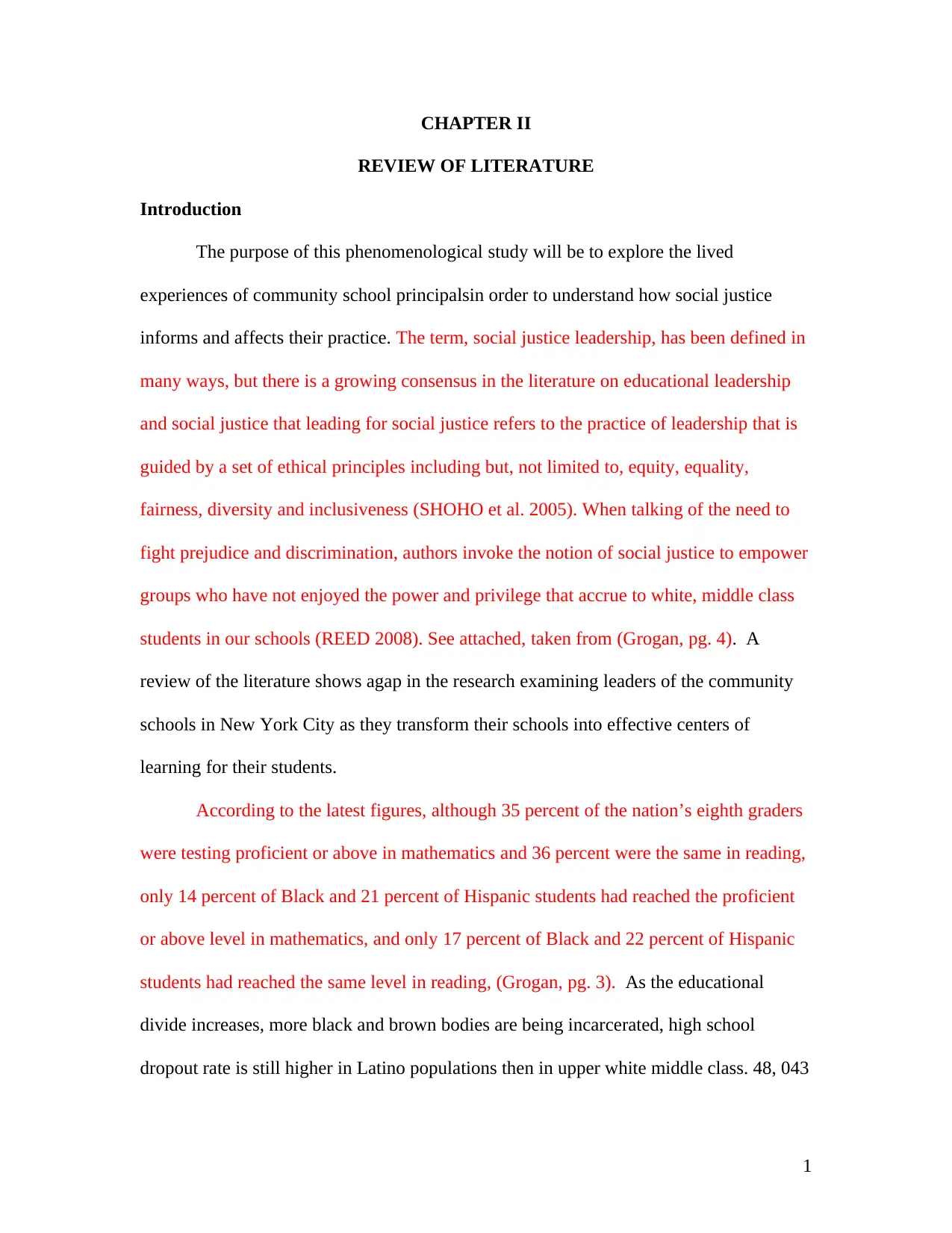
CHAPTER II
REVIEW OF LITERATURE
Introduction
The purpose of this phenomenological study will be to explore the lived
experiences of community school principalsin order to understand how social justice
informs and affects their practice. The term, social justice leadership, has been defined in
many ways, but there is a growing consensus in the literature on educational leadership
and social justice that leading for social justice refers to the practice of leadership that is
guided by a set of ethical principles including but, not limited to, equity, equality,
fairness, diversity and inclusiveness (SHOHO et al. 2005). When talking of the need to
fight prejudice and discrimination, authors invoke the notion of social justice to empower
groups who have not enjoyed the power and privilege that accrue to white, middle class
students in our schools (REED 2008). See attached, taken from (Grogan, pg. 4). A
review of the literature shows agap in the research examining leaders of the community
schools in New York City as they transform their schools into effective centers of
learning for their students.
According to the latest figures, although 35 percent of the nation’s eighth graders
were testing proficient or above in mathematics and 36 percent were the same in reading,
only 14 percent of Black and 21 percent of Hispanic students had reached the proficient
or above level in mathematics, and only 17 percent of Black and 22 percent of Hispanic
students had reached the same level in reading, (Grogan, pg. 3). As the educational
divide increases, more black and brown bodies are being incarcerated, high school
dropout rate is still higher in Latino populations then in upper white middle class. 48, 043
1
REVIEW OF LITERATURE
Introduction
The purpose of this phenomenological study will be to explore the lived
experiences of community school principalsin order to understand how social justice
informs and affects their practice. The term, social justice leadership, has been defined in
many ways, but there is a growing consensus in the literature on educational leadership
and social justice that leading for social justice refers to the practice of leadership that is
guided by a set of ethical principles including but, not limited to, equity, equality,
fairness, diversity and inclusiveness (SHOHO et al. 2005). When talking of the need to
fight prejudice and discrimination, authors invoke the notion of social justice to empower
groups who have not enjoyed the power and privilege that accrue to white, middle class
students in our schools (REED 2008). See attached, taken from (Grogan, pg. 4). A
review of the literature shows agap in the research examining leaders of the community
schools in New York City as they transform their schools into effective centers of
learning for their students.
According to the latest figures, although 35 percent of the nation’s eighth graders
were testing proficient or above in mathematics and 36 percent were the same in reading,
only 14 percent of Black and 21 percent of Hispanic students had reached the proficient
or above level in mathematics, and only 17 percent of Black and 22 percent of Hispanic
students had reached the same level in reading, (Grogan, pg. 3). As the educational
divide increases, more black and brown bodies are being incarcerated, high school
dropout rate is still higher in Latino populations then in upper white middle class. 48, 043
1
Paraphrase This Document
Need a fresh take? Get an instant paraphrase of this document with our AI Paraphraser
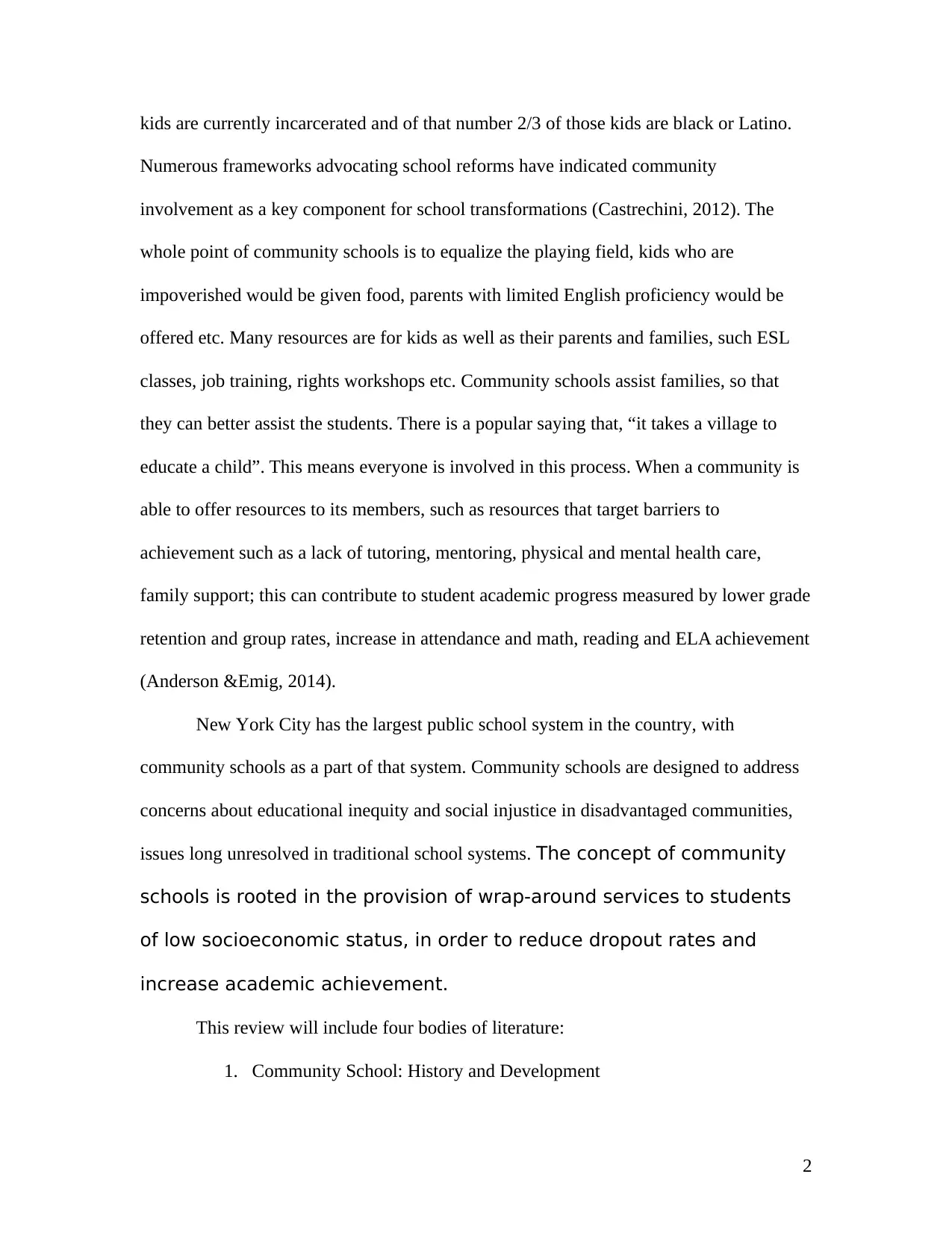
kids are currently incarcerated and of that number 2/3 of those kids are black or Latino.
Numerous frameworks advocating school reforms have indicated community
involvement as a key component for school transformations (Castrechini, 2012). The
whole point of community schools is to equalize the playing field, kids who are
impoverished would be given food, parents with limited English proficiency would be
offered etc. Many resources are for kids as well as their parents and families, such ESL
classes, job training, rights workshops etc. Community schools assist families, so that
they can better assist the students. There is a popular saying that, “it takes a village to
educate a child”. This means everyone is involved in this process. When a community is
able to offer resources to its members, such as resources that target barriers to
achievement such as a lack of tutoring, mentoring, physical and mental health care,
family support; this can contribute to student academic progress measured by lower grade
retention and group rates, increase in attendance and math, reading and ELA achievement
(Anderson &Emig, 2014).
New York City has the largest public school system in the country, with
community schools as a part of that system. Community schools are designed to address
concerns about educational inequity and social injustice in disadvantaged communities,
issues long unresolved in traditional school systems. The concept of community
schools is rooted in the provision of wrap-around services to students
of low socioeconomic status, in order to reduce dropout rates and
increase academic achievement.
This review will include four bodies of literature:
1. Community School: History and Development
2
Numerous frameworks advocating school reforms have indicated community
involvement as a key component for school transformations (Castrechini, 2012). The
whole point of community schools is to equalize the playing field, kids who are
impoverished would be given food, parents with limited English proficiency would be
offered etc. Many resources are for kids as well as their parents and families, such ESL
classes, job training, rights workshops etc. Community schools assist families, so that
they can better assist the students. There is a popular saying that, “it takes a village to
educate a child”. This means everyone is involved in this process. When a community is
able to offer resources to its members, such as resources that target barriers to
achievement such as a lack of tutoring, mentoring, physical and mental health care,
family support; this can contribute to student academic progress measured by lower grade
retention and group rates, increase in attendance and math, reading and ELA achievement
(Anderson &Emig, 2014).
New York City has the largest public school system in the country, with
community schools as a part of that system. Community schools are designed to address
concerns about educational inequity and social injustice in disadvantaged communities,
issues long unresolved in traditional school systems. The concept of community
schools is rooted in the provision of wrap-around services to students
of low socioeconomic status, in order to reduce dropout rates and
increase academic achievement.
This review will include four bodies of literature:
1. Community School: History and Development
2
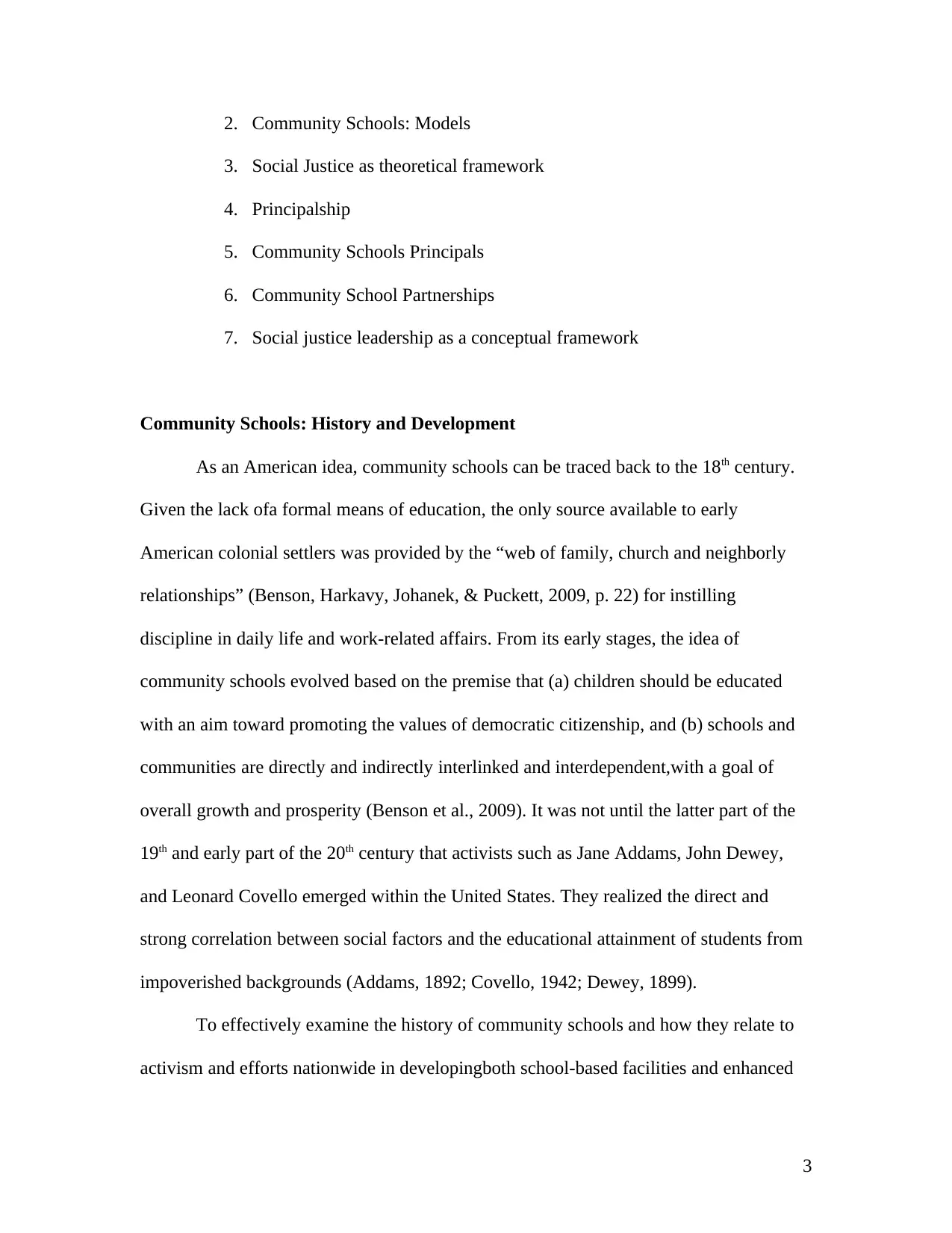
2. Community Schools: Models
3. Social Justice as theoretical framework
4. Principalship
5. Community Schools Principals
6. Community School Partnerships
7. Social justice leadership as a conceptual framework
Community Schools: History and Development
As an American idea, community schools can be traced back to the 18th century.
Given the lack ofa formal means of education, the only source available to early
American colonial settlers was provided by the “web of family, church and neighborly
relationships” (Benson, Harkavy, Johanek, & Puckett, 2009, p. 22) for instilling
discipline in daily life and work-related affairs. From its early stages, the idea of
community schools evolved based on the premise that (a) children should be educated
with an aim toward promoting the values of democratic citizenship, and (b) schools and
communities are directly and indirectly interlinked and interdependent,with a goal of
overall growth and prosperity (Benson et al., 2009). It was not until the latter part of the
19th and early part of the 20th century that activists such as Jane Addams, John Dewey,
and Leonard Covello emerged within the United States. They realized the direct and
strong correlation between social factors and the educational attainment of students from
impoverished backgrounds (Addams, 1892; Covello, 1942; Dewey, 1899).
To effectively examine the history of community schools and how they relate to
activism and efforts nationwide in developingboth school-based facilities and enhanced
3
3. Social Justice as theoretical framework
4. Principalship
5. Community Schools Principals
6. Community School Partnerships
7. Social justice leadership as a conceptual framework
Community Schools: History and Development
As an American idea, community schools can be traced back to the 18th century.
Given the lack ofa formal means of education, the only source available to early
American colonial settlers was provided by the “web of family, church and neighborly
relationships” (Benson, Harkavy, Johanek, & Puckett, 2009, p. 22) for instilling
discipline in daily life and work-related affairs. From its early stages, the idea of
community schools evolved based on the premise that (a) children should be educated
with an aim toward promoting the values of democratic citizenship, and (b) schools and
communities are directly and indirectly interlinked and interdependent,with a goal of
overall growth and prosperity (Benson et al., 2009). It was not until the latter part of the
19th and early part of the 20th century that activists such as Jane Addams, John Dewey,
and Leonard Covello emerged within the United States. They realized the direct and
strong correlation between social factors and the educational attainment of students from
impoverished backgrounds (Addams, 1892; Covello, 1942; Dewey, 1899).
To effectively examine the history of community schools and how they relate to
activism and efforts nationwide in developingboth school-based facilities and enhanced
3
⊘ This is a preview!⊘
Do you want full access?
Subscribe today to unlock all pages.

Trusted by 1+ million students worldwide
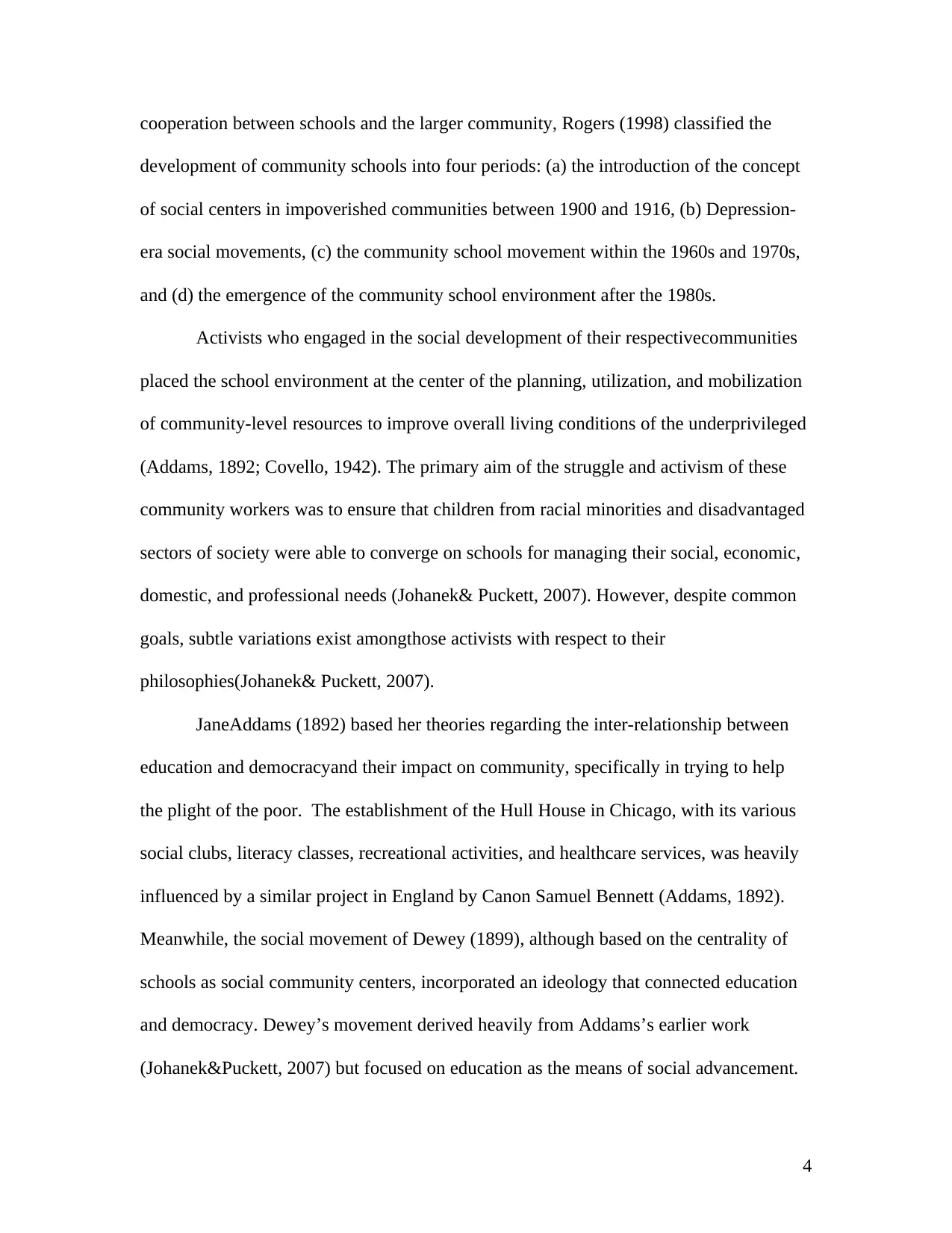
cooperation between schools and the larger community, Rogers (1998) classified the
development of community schools into four periods: (a) the introduction of the concept
of social centers in impoverished communities between 1900 and 1916, (b) Depression-
era social movements, (c) the community school movement within the 1960s and 1970s,
and (d) the emergence of the community school environment after the 1980s.
Activists who engaged in the social development of their respectivecommunities
placed the school environment at the center of the planning, utilization, and mobilization
of community-level resources to improve overall living conditions of the underprivileged
(Addams, 1892; Covello, 1942). The primary aim of the struggle and activism of these
community workers was to ensure that children from racial minorities and disadvantaged
sectors of society were able to converge on schools for managing their social, economic,
domestic, and professional needs (Johanek& Puckett, 2007). However, despite common
goals, subtle variations exist amongthose activists with respect to their
philosophies(Johanek& Puckett, 2007).
JaneAddams (1892) based her theories regarding the inter-relationship between
education and democracyand their impact on community, specifically in trying to help
the plight of the poor. The establishment of the Hull House in Chicago, with its various
social clubs, literacy classes, recreational activities, and healthcare services, was heavily
influenced by a similar project in England by Canon Samuel Bennett (Addams, 1892).
Meanwhile, the social movement of Dewey (1899), although based on the centrality of
schools as social community centers, incorporated an ideology that connected education
and democracy. Dewey’s movement derived heavily from Addams’s earlier work
(Johanek&Puckett, 2007) but focused on education as the means of social advancement.
4
development of community schools into four periods: (a) the introduction of the concept
of social centers in impoverished communities between 1900 and 1916, (b) Depression-
era social movements, (c) the community school movement within the 1960s and 1970s,
and (d) the emergence of the community school environment after the 1980s.
Activists who engaged in the social development of their respectivecommunities
placed the school environment at the center of the planning, utilization, and mobilization
of community-level resources to improve overall living conditions of the underprivileged
(Addams, 1892; Covello, 1942). The primary aim of the struggle and activism of these
community workers was to ensure that children from racial minorities and disadvantaged
sectors of society were able to converge on schools for managing their social, economic,
domestic, and professional needs (Johanek& Puckett, 2007). However, despite common
goals, subtle variations exist amongthose activists with respect to their
philosophies(Johanek& Puckett, 2007).
JaneAddams (1892) based her theories regarding the inter-relationship between
education and democracyand their impact on community, specifically in trying to help
the plight of the poor. The establishment of the Hull House in Chicago, with its various
social clubs, literacy classes, recreational activities, and healthcare services, was heavily
influenced by a similar project in England by Canon Samuel Bennett (Addams, 1892).
Meanwhile, the social movement of Dewey (1899), although based on the centrality of
schools as social community centers, incorporated an ideology that connected education
and democracy. Dewey’s movement derived heavily from Addams’s earlier work
(Johanek&Puckett, 2007) but focused on education as the means of social advancement.
4
Paraphrase This Document
Need a fresh take? Get an instant paraphrase of this document with our AI Paraphraser
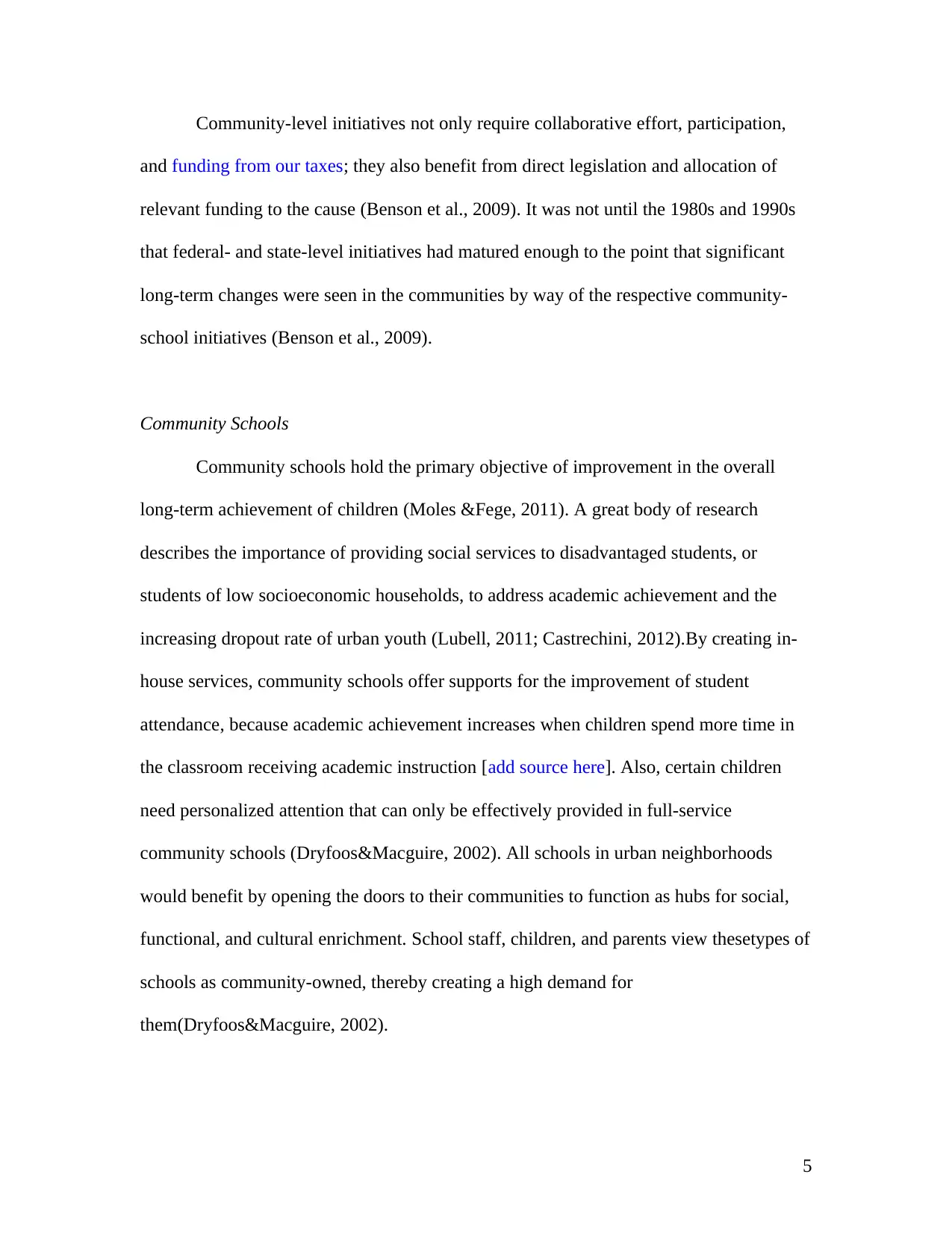
Community-level initiatives not only require collaborative effort, participation,
and funding from our taxes; they also benefit from direct legislation and allocation of
relevant funding to the cause (Benson et al., 2009). It was not until the 1980s and 1990s
that federal- and state-level initiatives had matured enough to the point that significant
long-term changes were seen in the communities by way of the respective community-
school initiatives (Benson et al., 2009).
Community Schools
Community schools hold the primary objective of improvement in the overall
long-term achievement of children (Moles &Fege, 2011). A great body of research
describes the importance of providing social services to disadvantaged students, or
students of low socioeconomic households, to address academic achievement and the
increasing dropout rate of urban youth (Lubell, 2011; Castrechini, 2012).By creating in-
house services, community schools offer supports for the improvement of student
attendance, because academic achievement increases when children spend more time in
the classroom receiving academic instruction [add source here]. Also, certain children
need personalized attention that can only be effectively provided in full-service
community schools (Dryfoos&Macguire, 2002). All schools in urban neighborhoods
would benefit by opening the doors to their communities to function as hubs for social,
functional, and cultural enrichment. School staff, children, and parents view thesetypes of
schools as community-owned, thereby creating a high demand for
them(Dryfoos&Macguire, 2002).
5
and funding from our taxes; they also benefit from direct legislation and allocation of
relevant funding to the cause (Benson et al., 2009). It was not until the 1980s and 1990s
that federal- and state-level initiatives had matured enough to the point that significant
long-term changes were seen in the communities by way of the respective community-
school initiatives (Benson et al., 2009).
Community Schools
Community schools hold the primary objective of improvement in the overall
long-term achievement of children (Moles &Fege, 2011). A great body of research
describes the importance of providing social services to disadvantaged students, or
students of low socioeconomic households, to address academic achievement and the
increasing dropout rate of urban youth (Lubell, 2011; Castrechini, 2012).By creating in-
house services, community schools offer supports for the improvement of student
attendance, because academic achievement increases when children spend more time in
the classroom receiving academic instruction [add source here]. Also, certain children
need personalized attention that can only be effectively provided in full-service
community schools (Dryfoos&Macguire, 2002). All schools in urban neighborhoods
would benefit by opening the doors to their communities to function as hubs for social,
functional, and cultural enrichment. School staff, children, and parents view thesetypes of
schools as community-owned, thereby creating a high demand for
them(Dryfoos&Macguire, 2002).
5
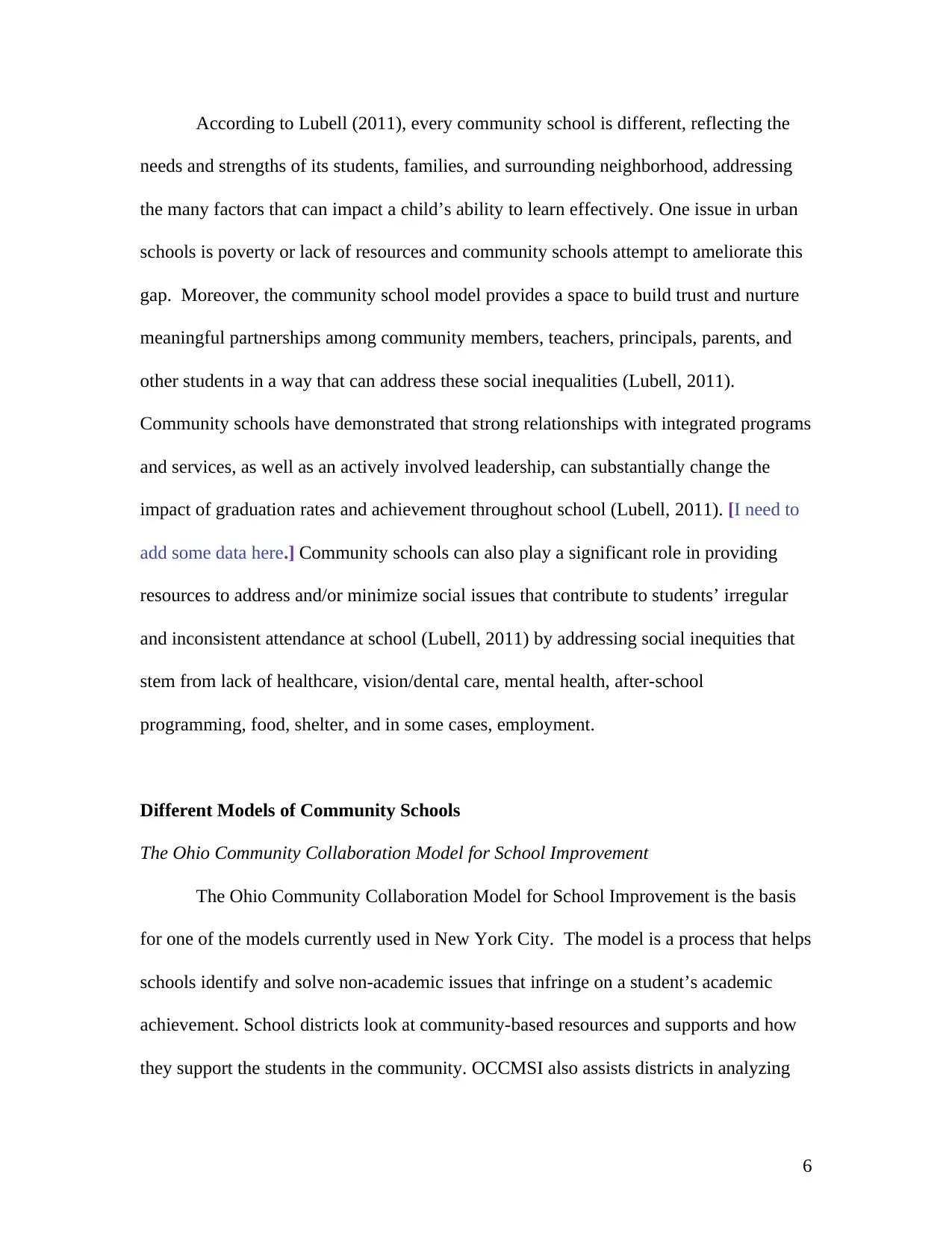
According to Lubell (2011), every community school is different, reflecting the
needs and strengths of its students, families, and surrounding neighborhood, addressing
the many factors that can impact a child’s ability to learn effectively. One issue in urban
schools is poverty or lack of resources and community schools attempt to ameliorate this
gap. Moreover, the community school model provides a space to build trust and nurture
meaningful partnerships among community members, teachers, principals, parents, and
other students in a way that can address these social inequalities (Lubell, 2011).
Community schools have demonstrated that strong relationships with integrated programs
and services, as well as an actively involved leadership, can substantially change the
impact of graduation rates and achievement throughout school (Lubell, 2011). [I need to
add some data here.] Community schools can also play a significant role in providing
resources to address and/or minimize social issues that contribute to students’ irregular
and inconsistent attendance at school (Lubell, 2011) by addressing social inequities that
stem from lack of healthcare, vision/dental care, mental health, after-school
programming, food, shelter, and in some cases, employment.
Different Models of Community Schools
The Ohio Community Collaboration Model for School Improvement
The Ohio Community Collaboration Model for School Improvement is the basis
for one of the models currently used in New York City. The model is a process that helps
schools identify and solve non-academic issues that infringe on a student’s academic
achievement. School districts look at community-based resources and supports and how
they support the students in the community. OCCMSI also assists districts in analyzing
6
needs and strengths of its students, families, and surrounding neighborhood, addressing
the many factors that can impact a child’s ability to learn effectively. One issue in urban
schools is poverty or lack of resources and community schools attempt to ameliorate this
gap. Moreover, the community school model provides a space to build trust and nurture
meaningful partnerships among community members, teachers, principals, parents, and
other students in a way that can address these social inequalities (Lubell, 2011).
Community schools have demonstrated that strong relationships with integrated programs
and services, as well as an actively involved leadership, can substantially change the
impact of graduation rates and achievement throughout school (Lubell, 2011). [I need to
add some data here.] Community schools can also play a significant role in providing
resources to address and/or minimize social issues that contribute to students’ irregular
and inconsistent attendance at school (Lubell, 2011) by addressing social inequities that
stem from lack of healthcare, vision/dental care, mental health, after-school
programming, food, shelter, and in some cases, employment.
Different Models of Community Schools
The Ohio Community Collaboration Model for School Improvement
The Ohio Community Collaboration Model for School Improvement is the basis
for one of the models currently used in New York City. The model is a process that helps
schools identify and solve non-academic issues that infringe on a student’s academic
achievement. School districts look at community-based resources and supports and how
they support the students in the community. OCCMSI also assists districts in analyzing
6
⊘ This is a preview!⊘
Do you want full access?
Subscribe today to unlock all pages.

Trusted by 1+ million students worldwide
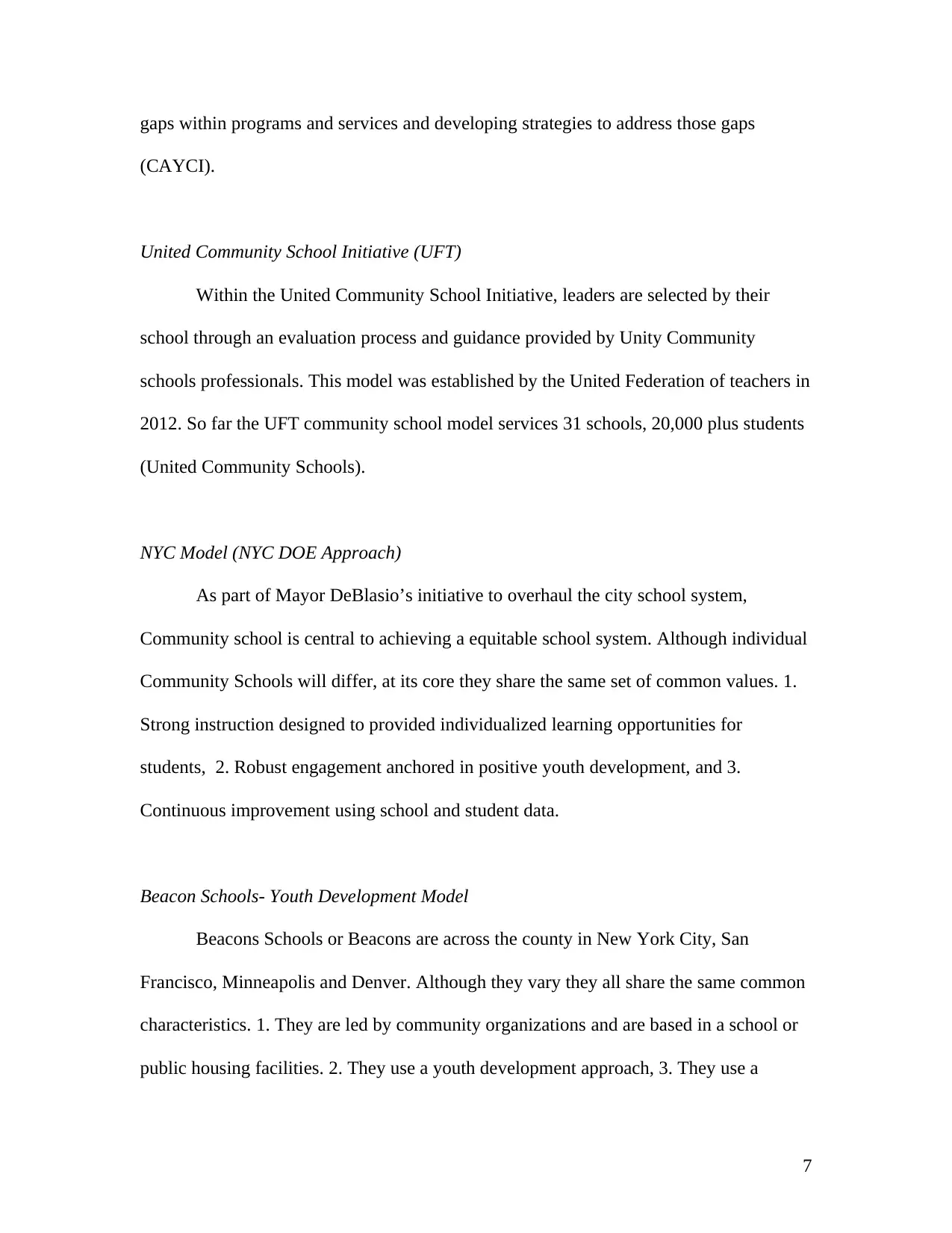
gaps within programs and services and developing strategies to address those gaps
(CAYCI).
United Community School Initiative (UFT)
Within the United Community School Initiative, leaders are selected by their
school through an evaluation process and guidance provided by Unity Community
schools professionals. This model was established by the United Federation of teachers in
2012. So far the UFT community school model services 31 schools, 20,000 plus students
(United Community Schools).
NYC Model (NYC DOE Approach)
As part of Mayor DeBlasio’s initiative to overhaul the city school system,
Community school is central to achieving a equitable school system. Although individual
Community Schools will differ, at its core they share the same set of common values. 1.
Strong instruction designed to provided individualized learning opportunities for
students, 2. Robust engagement anchored in positive youth development, and 3.
Continuous improvement using school and student data.
Beacon Schools- Youth Development Model
Beacons Schools or Beacons are across the county in New York City, San
Francisco, Minneapolis and Denver. Although they vary they all share the same common
characteristics. 1. They are led by community organizations and are based in a school or
public housing facilities. 2. They use a youth development approach, 3. They use a
7
(CAYCI).
United Community School Initiative (UFT)
Within the United Community School Initiative, leaders are selected by their
school through an evaluation process and guidance provided by Unity Community
schools professionals. This model was established by the United Federation of teachers in
2012. So far the UFT community school model services 31 schools, 20,000 plus students
(United Community Schools).
NYC Model (NYC DOE Approach)
As part of Mayor DeBlasio’s initiative to overhaul the city school system,
Community school is central to achieving a equitable school system. Although individual
Community Schools will differ, at its core they share the same set of common values. 1.
Strong instruction designed to provided individualized learning opportunities for
students, 2. Robust engagement anchored in positive youth development, and 3.
Continuous improvement using school and student data.
Beacon Schools- Youth Development Model
Beacons Schools or Beacons are across the county in New York City, San
Francisco, Minneapolis and Denver. Although they vary they all share the same common
characteristics. 1. They are led by community organizations and are based in a school or
public housing facilities. 2. They use a youth development approach, 3. They use a
7
Paraphrase This Document
Need a fresh take? Get an instant paraphrase of this document with our AI Paraphraser
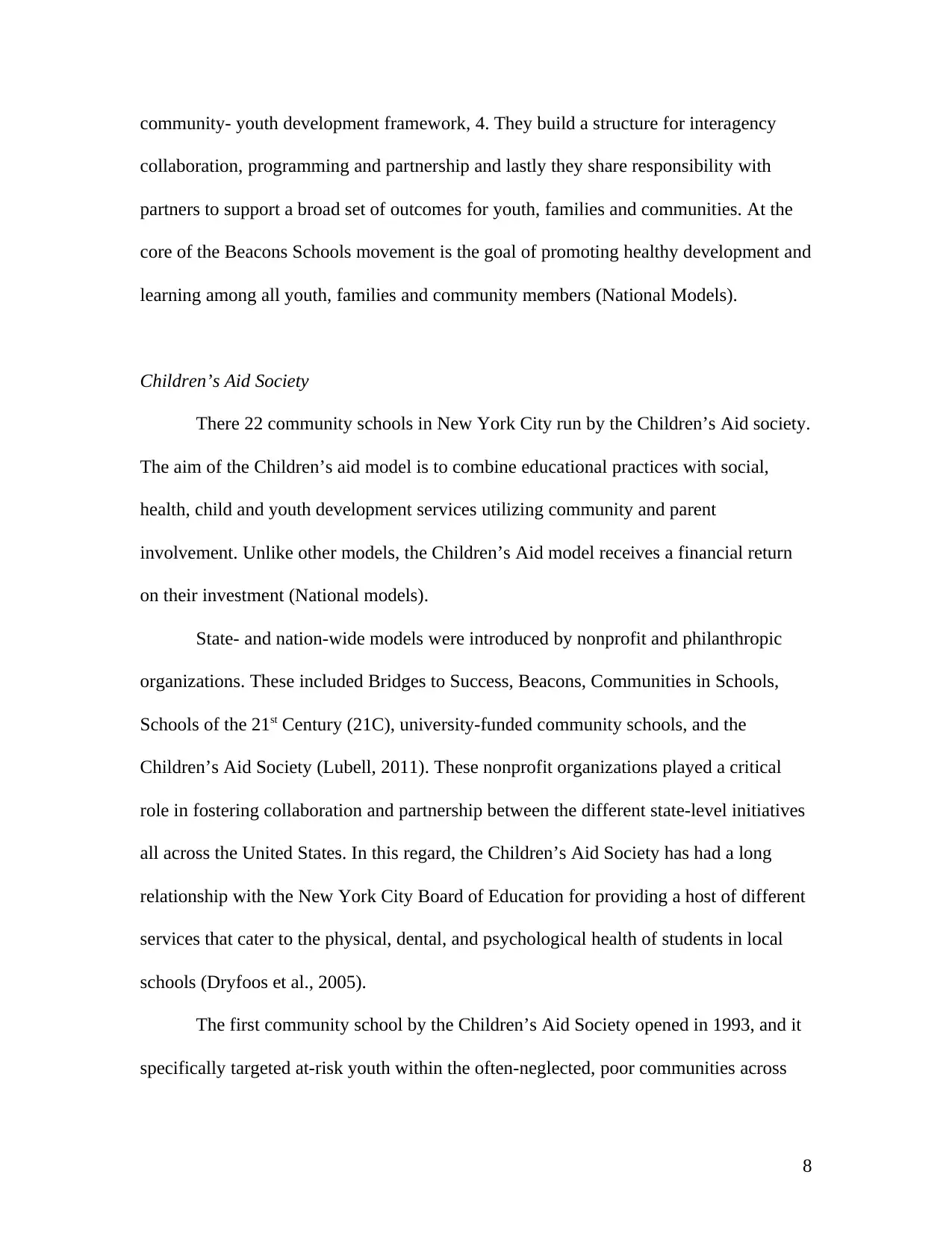
community- youth development framework, 4. They build a structure for interagency
collaboration, programming and partnership and lastly they share responsibility with
partners to support a broad set of outcomes for youth, families and communities. At the
core of the Beacons Schools movement is the goal of promoting healthy development and
learning among all youth, families and community members (National Models).
Children’s Aid Society
There 22 community schools in New York City run by the Children’s Aid society.
The aim of the Children’s aid model is to combine educational practices with social,
health, child and youth development services utilizing community and parent
involvement. Unlike other models, the Children’s Aid model receives a financial return
on their investment (National models).
State- and nation-wide models were introduced by nonprofit and philanthropic
organizations. These included Bridges to Success, Beacons, Communities in Schools,
Schools of the 21st Century (21C), university-funded community schools, and the
Children’s Aid Society (Lubell, 2011). These nonprofit organizations played a critical
role in fostering collaboration and partnership between the different state-level initiatives
all across the United States. In this regard, the Children’s Aid Society has had a long
relationship with the New York City Board of Education for providing a host of different
services that cater to the physical, dental, and psychological health of students in local
schools (Dryfoos et al., 2005).
The first community school by the Children’s Aid Society opened in 1993, and it
specifically targeted at-risk youth within the often-neglected, poor communities across
8
collaboration, programming and partnership and lastly they share responsibility with
partners to support a broad set of outcomes for youth, families and communities. At the
core of the Beacons Schools movement is the goal of promoting healthy development and
learning among all youth, families and community members (National Models).
Children’s Aid Society
There 22 community schools in New York City run by the Children’s Aid society.
The aim of the Children’s aid model is to combine educational practices with social,
health, child and youth development services utilizing community and parent
involvement. Unlike other models, the Children’s Aid model receives a financial return
on their investment (National models).
State- and nation-wide models were introduced by nonprofit and philanthropic
organizations. These included Bridges to Success, Beacons, Communities in Schools,
Schools of the 21st Century (21C), university-funded community schools, and the
Children’s Aid Society (Lubell, 2011). These nonprofit organizations played a critical
role in fostering collaboration and partnership between the different state-level initiatives
all across the United States. In this regard, the Children’s Aid Society has had a long
relationship with the New York City Board of Education for providing a host of different
services that cater to the physical, dental, and psychological health of students in local
schools (Dryfoos et al., 2005).
The first community school by the Children’s Aid Society opened in 1993, and it
specifically targeted at-risk youth within the often-neglected, poor communities across
8
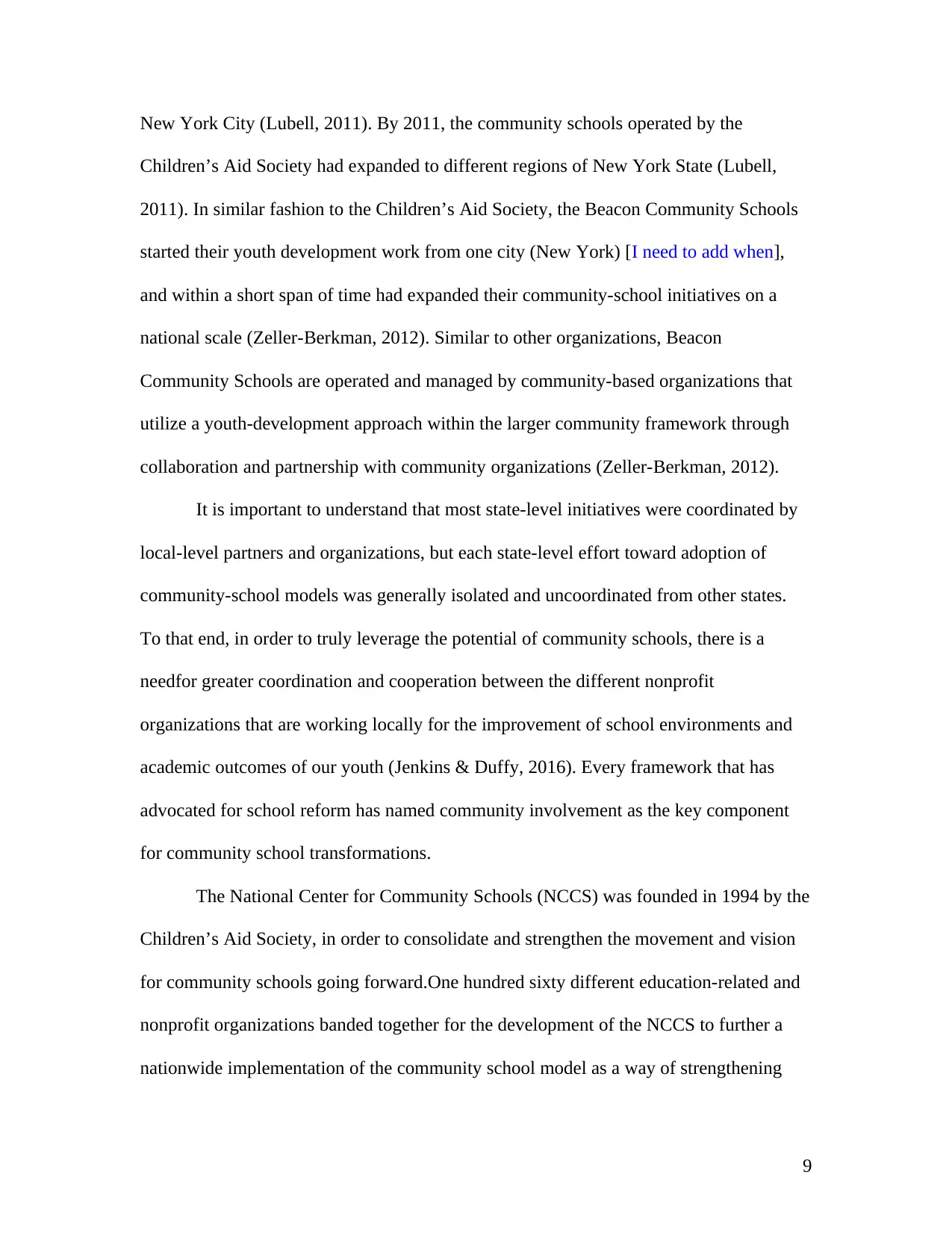
New York City (Lubell, 2011). By 2011, the community schools operated by the
Children’s Aid Society had expanded to different regions of New York State (Lubell,
2011). In similar fashion to the Children’s Aid Society, the Beacon Community Schools
started their youth development work from one city (New York) [I need to add when],
and within a short span of time had expanded their community-school initiatives on a
national scale (Zeller-Berkman, 2012). Similar to other organizations, Beacon
Community Schools are operated and managed by community-based organizations that
utilize a youth-development approach within the larger community framework through
collaboration and partnership with community organizations (Zeller-Berkman, 2012).
It is important to understand that most state-level initiatives were coordinated by
local-level partners and organizations, but each state-level effort toward adoption of
community-school models was generally isolated and uncoordinated from other states.
To that end, in order to truly leverage the potential of community schools, there is a
needfor greater coordination and cooperation between the different nonprofit
organizations that are working locally for the improvement of school environments and
academic outcomes of our youth (Jenkins & Duffy, 2016). Every framework that has
advocated for school reform has named community involvement as the key component
for community school transformations.
The National Center for Community Schools (NCCS) was founded in 1994 by the
Children’s Aid Society, in order to consolidate and strengthen the movement and vision
for community schools going forward.One hundred sixty different education-related and
nonprofit organizations banded together for the development of the NCCS to further a
nationwide implementation of the community school model as a way of strengthening
9
Children’s Aid Society had expanded to different regions of New York State (Lubell,
2011). In similar fashion to the Children’s Aid Society, the Beacon Community Schools
started their youth development work from one city (New York) [I need to add when],
and within a short span of time had expanded their community-school initiatives on a
national scale (Zeller-Berkman, 2012). Similar to other organizations, Beacon
Community Schools are operated and managed by community-based organizations that
utilize a youth-development approach within the larger community framework through
collaboration and partnership with community organizations (Zeller-Berkman, 2012).
It is important to understand that most state-level initiatives were coordinated by
local-level partners and organizations, but each state-level effort toward adoption of
community-school models was generally isolated and uncoordinated from other states.
To that end, in order to truly leverage the potential of community schools, there is a
needfor greater coordination and cooperation between the different nonprofit
organizations that are working locally for the improvement of school environments and
academic outcomes of our youth (Jenkins & Duffy, 2016). Every framework that has
advocated for school reform has named community involvement as the key component
for community school transformations.
The National Center for Community Schools (NCCS) was founded in 1994 by the
Children’s Aid Society, in order to consolidate and strengthen the movement and vision
for community schools going forward.One hundred sixty different education-related and
nonprofit organizations banded together for the development of the NCCS to further a
nationwide implementation of the community school model as a way of strengthening
9
⊘ This is a preview!⊘
Do you want full access?
Subscribe today to unlock all pages.

Trusted by 1+ million students worldwide
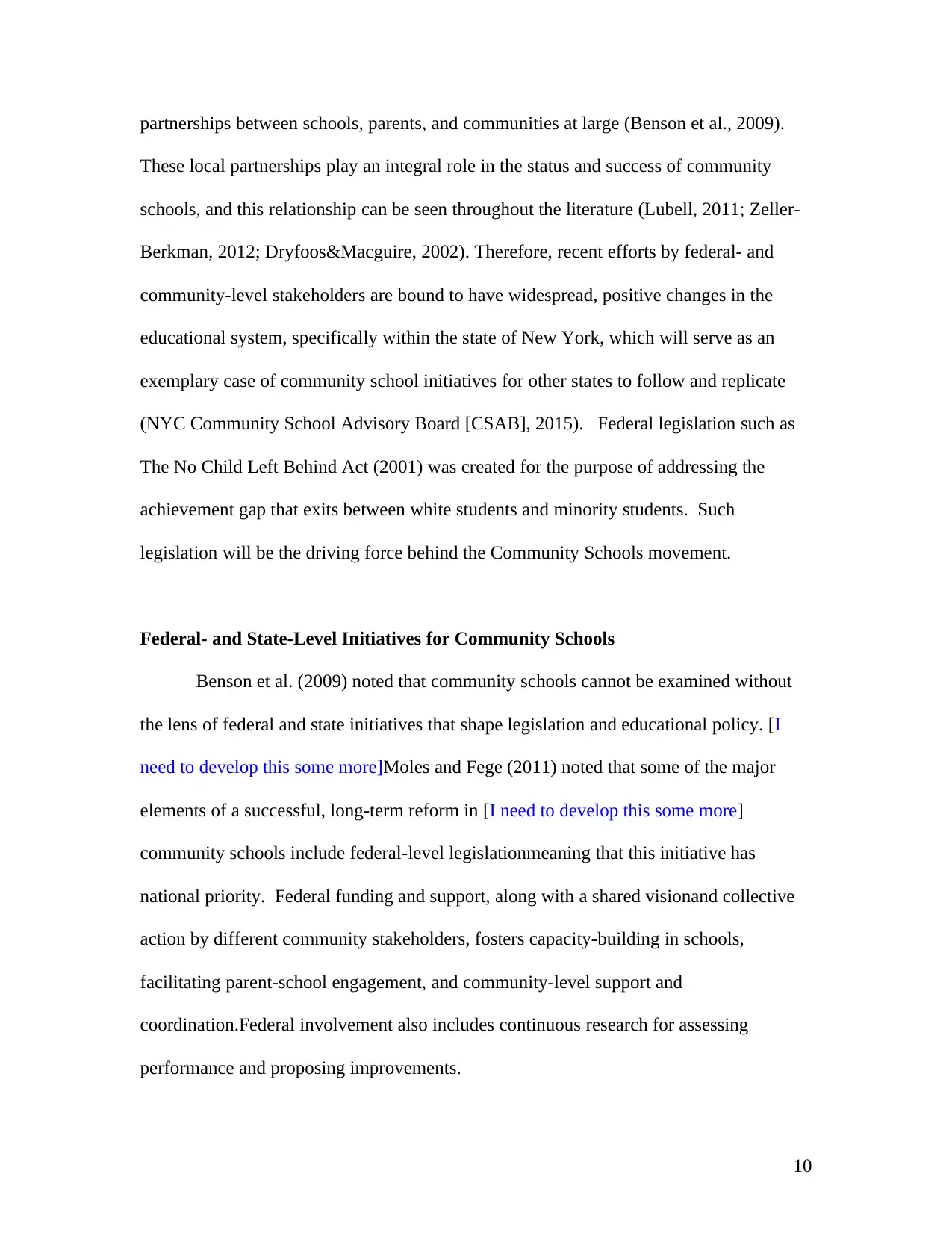
partnerships between schools, parents, and communities at large (Benson et al., 2009).
These local partnerships play an integral role in the status and success of community
schools, and this relationship can be seen throughout the literature (Lubell, 2011; Zeller-
Berkman, 2012; Dryfoos&Macguire, 2002). Therefore, recent efforts by federal- and
community-level stakeholders are bound to have widespread, positive changes in the
educational system, specifically within the state of New York, which will serve as an
exemplary case of community school initiatives for other states to follow and replicate
(NYC Community School Advisory Board [CSAB], 2015). Federal legislation such as
The No Child Left Behind Act (2001) was created for the purpose of addressing the
achievement gap that exits between white students and minority students. Such
legislation will be the driving force behind the Community Schools movement.
Federal- and State-Level Initiatives for Community Schools
Benson et al. (2009) noted that community schools cannot be examined without
the lens of federal and state initiatives that shape legislation and educational policy. [I
need to develop this some more]Moles and Fege (2011) noted that some of the major
elements of a successful, long-term reform in [I need to develop this some more]
community schools include federal-level legislationmeaning that this initiative has
national priority. Federal funding and support, along with a shared visionand collective
action by different community stakeholders, fosters capacity-building in schools,
facilitating parent-school engagement, and community-level support and
coordination.Federal involvement also includes continuous research for assessing
performance and proposing improvements.
10
These local partnerships play an integral role in the status and success of community
schools, and this relationship can be seen throughout the literature (Lubell, 2011; Zeller-
Berkman, 2012; Dryfoos&Macguire, 2002). Therefore, recent efforts by federal- and
community-level stakeholders are bound to have widespread, positive changes in the
educational system, specifically within the state of New York, which will serve as an
exemplary case of community school initiatives for other states to follow and replicate
(NYC Community School Advisory Board [CSAB], 2015). Federal legislation such as
The No Child Left Behind Act (2001) was created for the purpose of addressing the
achievement gap that exits between white students and minority students. Such
legislation will be the driving force behind the Community Schools movement.
Federal- and State-Level Initiatives for Community Schools
Benson et al. (2009) noted that community schools cannot be examined without
the lens of federal and state initiatives that shape legislation and educational policy. [I
need to develop this some more]Moles and Fege (2011) noted that some of the major
elements of a successful, long-term reform in [I need to develop this some more]
community schools include federal-level legislationmeaning that this initiative has
national priority. Federal funding and support, along with a shared visionand collective
action by different community stakeholders, fosters capacity-building in schools,
facilitating parent-school engagement, and community-level support and
coordination.Federal involvement also includes continuous research for assessing
performance and proposing improvements.
10
Paraphrase This Document
Need a fresh take? Get an instant paraphrase of this document with our AI Paraphraser
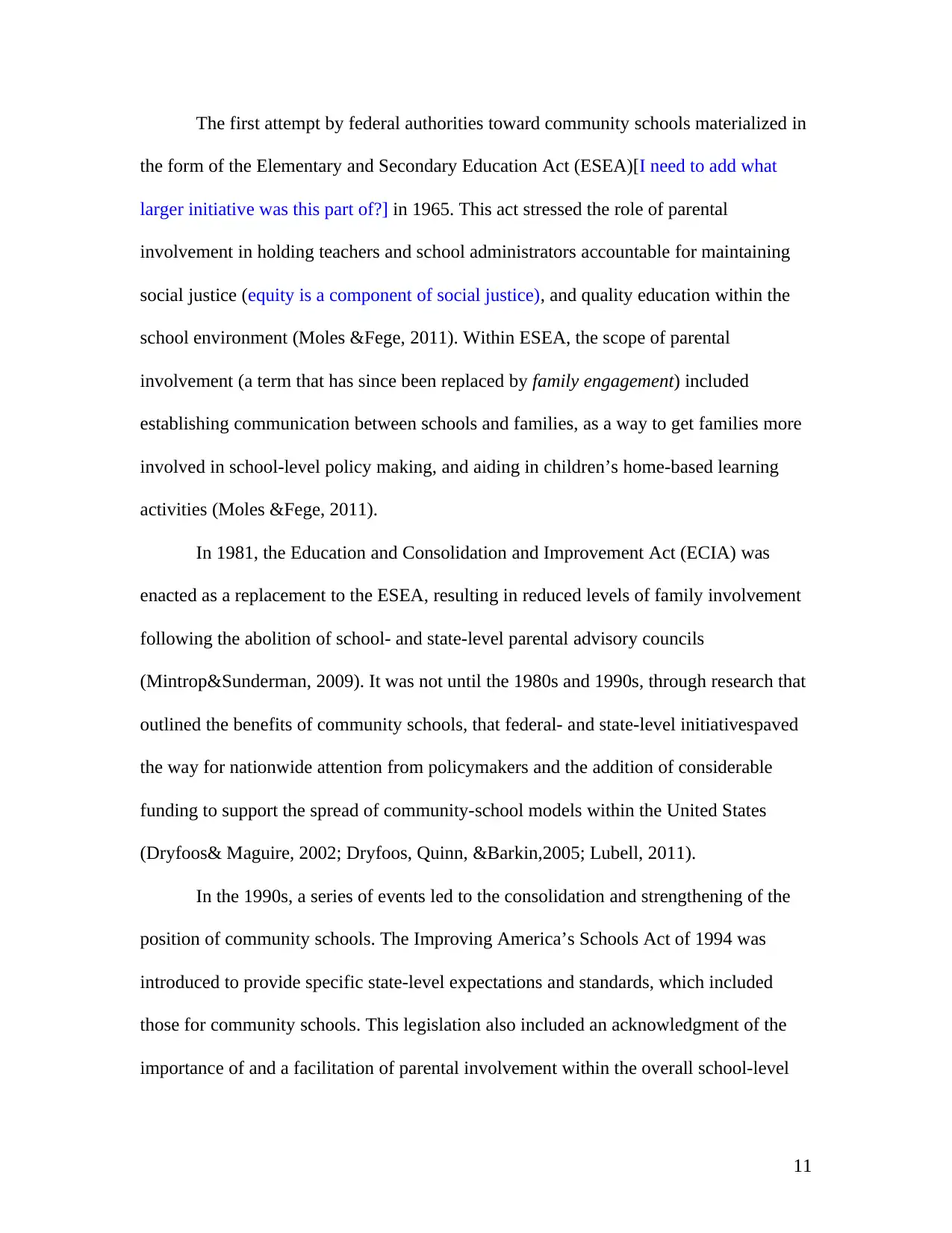
The first attempt by federal authorities toward community schools materialized in
the form of the Elementary and Secondary Education Act (ESEA)[I need to add what
larger initiative was this part of?] in 1965. This act stressed the role of parental
involvement in holding teachers and school administrators accountable for maintaining
social justice (equity is a component of social justice), and quality education within the
school environment (Moles &Fege, 2011). Within ESEA, the scope of parental
involvement (a term that has since been replaced by family engagement) included
establishing communication between schools and families, as a way to get families more
involved in school-level policy making, and aiding in children’s home-based learning
activities (Moles &Fege, 2011).
In 1981, the Education and Consolidation and Improvement Act (ECIA) was
enacted as a replacement to the ESEA, resulting in reduced levels of family involvement
following the abolition of school- and state-level parental advisory councils
(Mintrop&Sunderman, 2009). It was not until the 1980s and 1990s, through research that
outlined the benefits of community schools, that federal- and state-level initiativespaved
the way for nationwide attention from policymakers and the addition of considerable
funding to support the spread of community-school models within the United States
(Dryfoos& Maguire, 2002; Dryfoos, Quinn, &Barkin,2005; Lubell, 2011).
In the 1990s, a series of events led to the consolidation and strengthening of the
position of community schools. The Improving America’s Schools Act of 1994 was
introduced to provide specific state-level expectations and standards, which included
those for community schools. This legislation also included an acknowledgment of the
importance of and a facilitation of parental involvement within the overall school-level
11
the form of the Elementary and Secondary Education Act (ESEA)[I need to add what
larger initiative was this part of?] in 1965. This act stressed the role of parental
involvement in holding teachers and school administrators accountable for maintaining
social justice (equity is a component of social justice), and quality education within the
school environment (Moles &Fege, 2011). Within ESEA, the scope of parental
involvement (a term that has since been replaced by family engagement) included
establishing communication between schools and families, as a way to get families more
involved in school-level policy making, and aiding in children’s home-based learning
activities (Moles &Fege, 2011).
In 1981, the Education and Consolidation and Improvement Act (ECIA) was
enacted as a replacement to the ESEA, resulting in reduced levels of family involvement
following the abolition of school- and state-level parental advisory councils
(Mintrop&Sunderman, 2009). It was not until the 1980s and 1990s, through research that
outlined the benefits of community schools, that federal- and state-level initiativespaved
the way for nationwide attention from policymakers and the addition of considerable
funding to support the spread of community-school models within the United States
(Dryfoos& Maguire, 2002; Dryfoos, Quinn, &Barkin,2005; Lubell, 2011).
In the 1990s, a series of events led to the consolidation and strengthening of the
position of community schools. The Improving America’s Schools Act of 1994 was
introduced to provide specific state-level expectations and standards, which included
those for community schools. This legislation also included an acknowledgment of the
importance of and a facilitation of parental involvement within the overall school-level
11
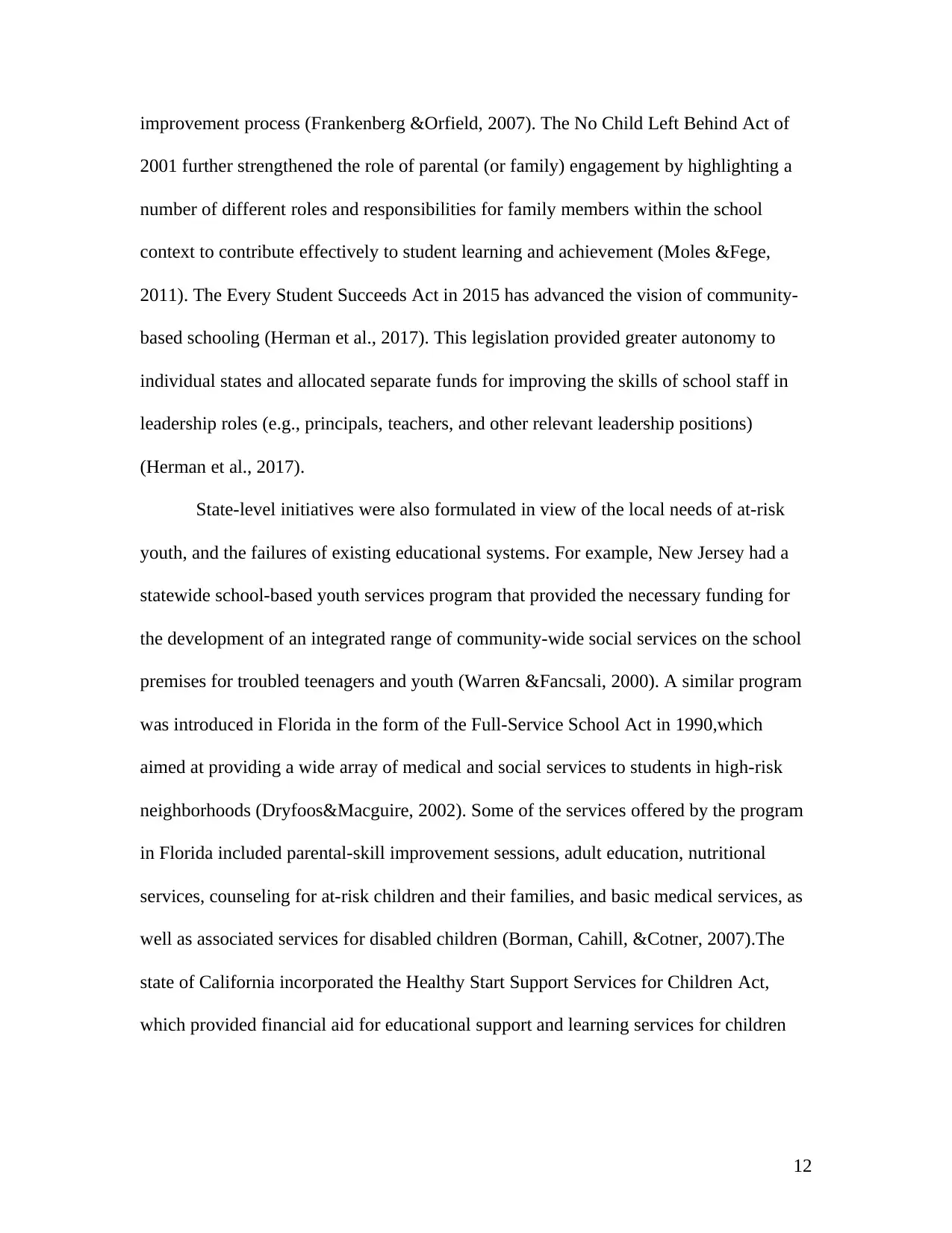
improvement process (Frankenberg &Orfield, 2007). The No Child Left Behind Act of
2001 further strengthened the role of parental (or family) engagement by highlighting a
number of different roles and responsibilities for family members within the school
context to contribute effectively to student learning and achievement (Moles &Fege,
2011). The Every Student Succeeds Act in 2015 has advanced the vision of community-
based schooling (Herman et al., 2017). This legislation provided greater autonomy to
individual states and allocated separate funds for improving the skills of school staff in
leadership roles (e.g., principals, teachers, and other relevant leadership positions)
(Herman et al., 2017).
State-level initiatives were also formulated in view of the local needs of at-risk
youth, and the failures of existing educational systems. For example, New Jersey had a
statewide school-based youth services program that provided the necessary funding for
the development of an integrated range of community-wide social services on the school
premises for troubled teenagers and youth (Warren &Fancsali, 2000). A similar program
was introduced in Florida in the form of the Full-Service School Act in 1990,which
aimed at providing a wide array of medical and social services to students in high-risk
neighborhoods (Dryfoos&Macguire, 2002). Some of the services offered by the program
in Florida included parental-skill improvement sessions, adult education, nutritional
services, counseling for at-risk children and their families, and basic medical services, as
well as associated services for disabled children (Borman, Cahill, &Cotner, 2007).The
state of California incorporated the Healthy Start Support Services for Children Act,
which provided financial aid for educational support and learning services for children
12
2001 further strengthened the role of parental (or family) engagement by highlighting a
number of different roles and responsibilities for family members within the school
context to contribute effectively to student learning and achievement (Moles &Fege,
2011). The Every Student Succeeds Act in 2015 has advanced the vision of community-
based schooling (Herman et al., 2017). This legislation provided greater autonomy to
individual states and allocated separate funds for improving the skills of school staff in
leadership roles (e.g., principals, teachers, and other relevant leadership positions)
(Herman et al., 2017).
State-level initiatives were also formulated in view of the local needs of at-risk
youth, and the failures of existing educational systems. For example, New Jersey had a
statewide school-based youth services program that provided the necessary funding for
the development of an integrated range of community-wide social services on the school
premises for troubled teenagers and youth (Warren &Fancsali, 2000). A similar program
was introduced in Florida in the form of the Full-Service School Act in 1990,which
aimed at providing a wide array of medical and social services to students in high-risk
neighborhoods (Dryfoos&Macguire, 2002). Some of the services offered by the program
in Florida included parental-skill improvement sessions, adult education, nutritional
services, counseling for at-risk children and their families, and basic medical services, as
well as associated services for disabled children (Borman, Cahill, &Cotner, 2007).The
state of California incorporated the Healthy Start Support Services for Children Act,
which provided financial aid for educational support and learning services for children
12
⊘ This is a preview!⊘
Do you want full access?
Subscribe today to unlock all pages.

Trusted by 1+ million students worldwide
1 out of 36
Your All-in-One AI-Powered Toolkit for Academic Success.
+13062052269
info@desklib.com
Available 24*7 on WhatsApp / Email
![[object Object]](/_next/static/media/star-bottom.7253800d.svg)
Unlock your academic potential
Copyright © 2020–2025 A2Z Services. All Rights Reserved. Developed and managed by ZUCOL.

